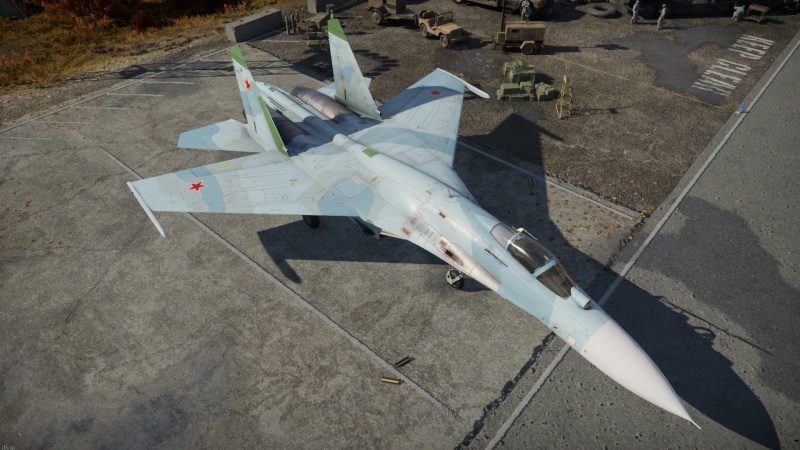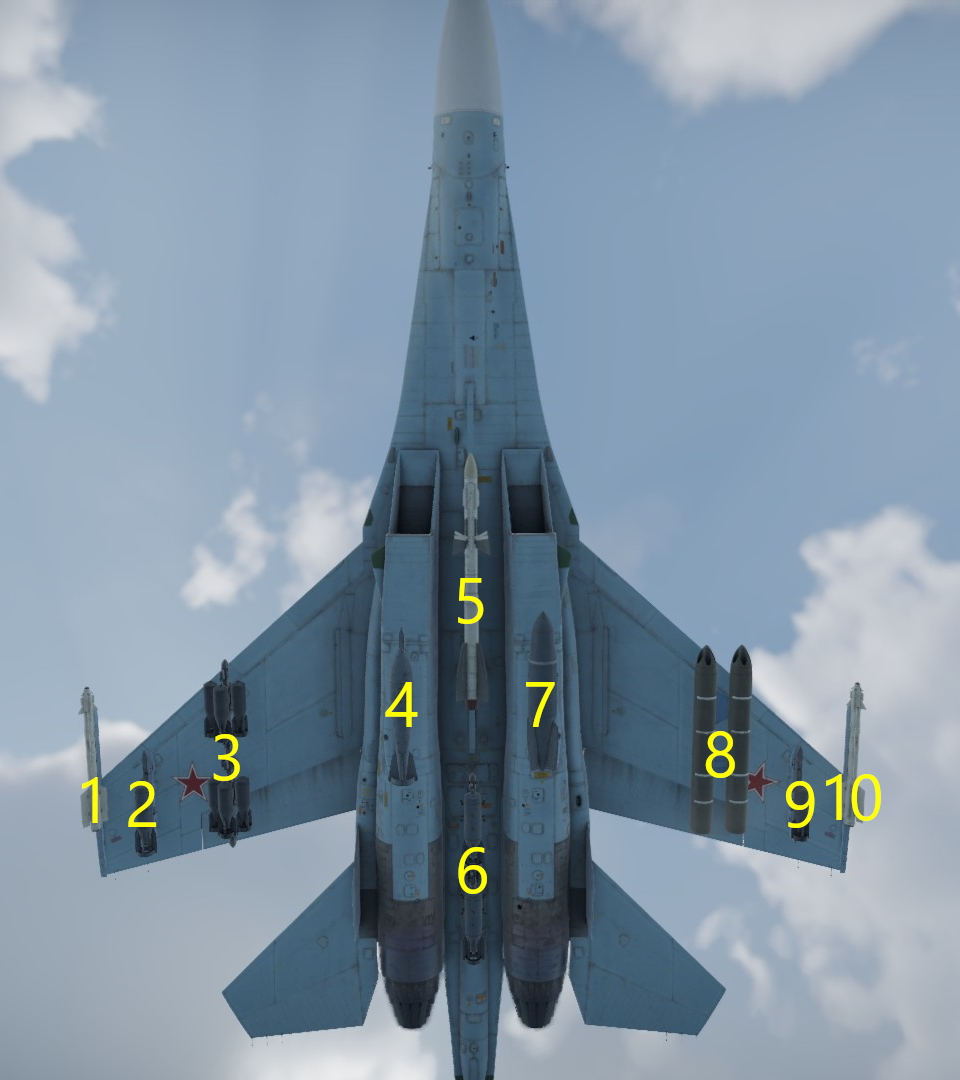Su-27
Contents
Description
Shortly after the Vietnam War, both the United States and the Soviet Union got to work on a new generation of fighter aircraft that favoured manoeuvrability and dogfight performance over top speed, after seeing how badly "missile truck" designs like the F-4 Phantom II performed against more nimble aircraft that were as much as 20 years older. In 1969, the Soviet Union received details through spies on the USAF's F-X program and the aircraft it was leading to, the F-15 Eagle. As a result, the Soviets also decided to adopt a "Heavy support" doctrine with their new generation of fighters, with a smaller amount of a larger, more powerful aircraft supporting a larger amount of smaller, cheaper "frontline" aircraft just as the US was going to do with the F-15 and F-16 respectively. The design of the heavy fighter was handed to OKB Sukhoi, which quickly produced the T-10 prototype. The T-10 had many shortcomings, and after a lot of work with TsAGI to iron out the issues, the Su-27 would take to the skies for the first time in 1977. Development would continue further, and the first true "production models" would only enter service in 1985, beginning a fruitious life in Soviet service, and later in Chinese, Ethiopian, Vietnamese, Eritrian, Indonesian, Ukranian, Kazakh, Uzbekh, and Russian service with many aircraft of the type still seeing combat today.
The Su-27 (NATO reporting name: Flanker) was introduced in Update "Air Superiority" as the top-end heavy fighter for the USSR tree, capping off the Sukhoi line and beginning its transition from high speed fighter-bombers to the venerable Flanker family. The Su-27 is a jack of all trades yet a master of almost none, and that playstyle is its strongest suite. The Flanker carries a very generous amount of air to air missiles (ten), including up to six heat-seeking missiles with HMD targeting, and four of the infamous R-27ER coupled with the strong N001 Mech radar. The Flanker's lethal missile selection allows it to dispatch distracted many enemies at safe distances, and when push comes to shove, the Flanker's inherently unstable airframe and fly-by-wire control systems allows it to perform high angle-of-attack manoeuvres and partial post-stall manoeuvres at lower speeds, including the famed Cobra manoeuvres. All in all, the Su-27 should be played as a jack of all trades, and fits best into a very aggressive playable due to its lethal missiles, great avionics and sensors, and nimble flight performance. One must, however, be aware of various enemies you can encounter in the Flanker, such as all the aircraft that carry IRCCM missiles due to the Flanker's large heat signature as a result of the two massive AL-31 engines, but also be careful of dogfighting aircraft from the F-15 Eagle family, as the Eagle's superior TWR and high-speed handling as a result of the stable airframe will give F-15 players an advantage in some scenarios.
General info
Flight performance
Describe how the aircraft behaves in the air. Speed, manoeuvrability, acceleration and allowable loads - these are the most important characteristics of the vehicle.
| Characteristics | Max speed (km/h at _,___ m) |
Max altitude (metres) |
Turn time (seconds) |
Rate of climb (metres/second) |
Take-off run (metres) | |||
|---|---|---|---|---|---|---|---|---|
| AB | RB | AB | RB | AB | RB | |||
| Stock | ___ | ___ | 16000 | __._ | __._ | __._ | __._ | ___ |
| Upgraded | ___ | ___ | __._ | __._ | __._ | __._ | ||
Details
| Features | |||||
|---|---|---|---|---|---|
| Combat flaps | Take-off flaps | Landing flaps | Air brakes | Arrestor gear | Drogue chute |
| _ | _ | _ | ✓ | _ | ✓ |
| Limits | ||||||
|---|---|---|---|---|---|---|
| Wings (km/h) | Gear (km/h) | Flaps (km/h) | Max Static G | |||
| Combat | Take-off | Landing | + | - | ||
| 0 | 700 | ___ | ___ | ___ | ~__ | ~__ |
| Optimal velocities (km/h) | |||
|---|---|---|---|
| Ailerons | Rudder | Elevators | Radiator |
| < ___ | < ___ | < ___ | - |
Engine performance
| Engine | Aircraft mass | |||||
|---|---|---|---|---|---|---|
| Engine name | Number | Basic mass | Wing loading (full fuel) | |||
| _____ | _ | _,___ kg | ___ kg/m2 | |||
| Engine characteristics | Mass with fuel (no weapons load) | Max Gross Weight | ||||
| Weight (each) | Type | _m fuel | __m fuel | __m fuel | ||
| ___ kg | ___ | _,___ kg | _,___ kg | _,___ kg | _,___ kg | |
| Maximum engine thrust @ 0 m (RB/SB) | Thrust to weight ratio @ 0 m (___%/WEP) | |||||
| Condition | 100% | ___%/WEP | _m fuel | __m fuel | __m fuel | MGW |
| Stationary | ___ kgf | ___ kgf | _.__ | _.__ | _.__ | _.__ |
| Optimal | ___ kgf (_ km/h) |
___ kgf (_ km/h) |
_.__ | _.__ | _.__ | _.__ |
Survivability and armour
Examine the survivability of the aircraft. Note how vulnerable the structure is and how secure the pilot is, whether the fuel tanks are armoured, etc. Describe the armour, if there is any, and also mention the vulnerability of other critical aircraft systems.
Modifications and economy
Armaments
| Ballistic Computer | ||||
|---|---|---|---|---|
| CCIP (Guns) | CCIP (Rockets) | CCIP (Bombs) | CCRP (Bombs) | Lead indicator |
| |
|
|
|
|
Offensive armament
The Su-27 is armed with:
- 1 x 30 mm GSh-30-1 cannon, wing root-mounted (150 rpg)
- 96 x large calibre countermeasures
Suspended armament
The Su-27 can be outfitted with the following ordnance:
| 1 | 2 | 3 | 4 | 5 | 6 | 7 | 8 | 9 | 10 | ||
|---|---|---|---|---|---|---|---|---|---|---|---|
| 100 kg OFAB-100 bombs | 1 | 6 | 6 | 6 | 6 | 6 | 6 | 1 | |||
| 250 kg FAB-250M-62 bombs | 1, 2 | 1 | 1 | 1 | 1 | 1, 2 | |||||
| 250 kg OFAB-250-270 bombs | 1 | 1, 2, 6 | 1, 5 | 1, 4 | 1, 2 | 1, 5 | 1, 2, 6 | 1 | |||
| 250 kg OFAB-250Sh bombs | 1, 2 | 1 | 1 | 1 | 1 | 1, 2 | |||||
| 500 kg FAB-500M-62 bombs | 1, 2 | 1 | 1 | 1 | 1 | 1, 2 | |||||
| 500 kg FAB-500Sh bombs | 1, 2 | 1 | 1 | 1 | 1 | 1, 2 | |||||
| ZB-500 incendiary bombs | 1, 2 | 1 | 1 | 1 | 1 | 1, 2 | |||||
| S-8KO rockets | 20, 40 | 20, 40 | |||||||||
| S-13OF rockets | 5, 10 | 5, 10 | |||||||||
| S-25O rockets | 1, 2 | 1, 2 | |||||||||
| S-25OF rockets | 1, 2 | 1, 2 | |||||||||
| S-25OFM rockets | 1, 2 | 1, 2 | |||||||||
| R-27ER missiles | 1 | 1 | 1 | 1 | 1 | 1 | |||||
| R-27ET missiles | 1 | 1 | |||||||||
| R-27R missiles | 1 | 1 | 1 | 1 | 1 | 1 | |||||
| R-27T missiles | 1 | 1 | |||||||||
| R-73 missiles | 1 | 1 | 1 | 1 | 1 | 1 | |||||
| Maximum permissible weight imbalance: 1,500 kg | |||||||||||
| Default weapon presets | |
|---|---|
| |
Usage in battles
Describe the tactics of playing in the aircraft, the features of using aircraft in a team and advice on tactics. Refrain from creating a "guide" - do not impose a single point of view, but instead, give the reader food for thought. Examine the most dangerous enemies and give recommendations on fighting them. If necessary, note the specifics of the game in different modes (AB, RB, SB).
Pros and cons
Summarise and briefly evaluate the vehicle in terms of its characteristics and combat effectiveness. Mark its pros and cons in the bulleted list. Try not to use more than 6 points for each of the characteristics. Avoid using categorical definitions such as "bad", "good" and the like - use substitutions with softer forms such as "inadequate" and "effective".
Pros:
Cons:
History
Describe the history of the creation and combat usage of the aircraft in more detail than in the introduction. If the historical reference turns out to be too long, take it to a separate article, taking a link to the article about the vehicle and adding a block "/History" (example: https://wiki.warthunder.com/(Vehicle-name)/History) and add a link to it here using the main template. Be sure to reference text and sources by using <ref></ref>, as well as adding them at the end of the article with <references />. This section may also include the vehicle's dev blog entry (if applicable) and the in-game encyclopedia description (under === In-game description ===, also if applicable).
Media
Excellent additions to the article would be video guides, screenshots from the game, and photos.
See also
Links to the articles on the War Thunder Wiki that you think will be useful for the reader, for example:
- reference to the series of the aircraft;
- links to approximate analogues of other nations and research trees.
External links
Paste links to sources and external resources, such as:
- topic on the official game forum;
- other literature.
| Sukhoi Design Bureau (Сухого Опытное конструкторское бюро) | |
|---|---|
| Jet fighters | Su-9 · Su-11 |
| Su-27 | Su-27 · Su-27SM |
| Strike aircraft | |
| Su-2 | BB-1 · Su-2 (M-82) · Su-2 MV-5 · Su-2 TSS-1 |
| Su-6 | Su-6 · Su-6 (AM-42) · Su-6 (M-71F) |
| Su-7 | Su-7B · Su-7BKL · Su-7BMK |
| Su-8 | Su-8 |
| Su-17 | Su-17M2 · Su-17M4 · Su-22M3 |
| Su-24 | Su-24M |
| Su-25 | Su-25 · Su-25BM · Su-25K · Su-25T · Su-25SM3 · Su-39 |
| Su-34 | Su-34 |
| Export | ◊Su-22UM3K · ◔Su-22M3 · ◊Su-22M4 · ◄Su-22M4 WTD61 |
| J-11* | |
| *CKD and SKD kits assembled by Shenyang Aircraft Corporation | |
| USSR jet aircraft | |
|---|---|
| Bereznyak-Isayev | BI |
| Yakovlev | Yak-15 · Yak-15P · Yak-17 · Yak-23 · Yak-28B · Yak-30D · Yak-38 · Yak-38M · Yak-141 |
| Mikoyan-Gurevich | MiG-9 · MiG-9 (l) · MiG-15 · MiG-15bis · MiG-15bis ISh · MiG-17 · MiG-17AS · MiG-19PT |
| MiG-21F-13 · MiG-21PFM · MiG-21S (R-13-300) · MiG-21SMT · MiG-21bis | |
| MiG-23M · MiG-23ML · MiG-23MLD · MiG-27M · MiG-27K | |
| MiG-29 · MiG-29SMT | |
| Lavochkin | La-174 · La-15 · La-200 |
| Sukhoi | Su-9 · Su-11 |
| Su-7B · Su-7BKL · Su-7BMK · Su-17M2 · Su-17M4 · Su-22M3 | |
| Su-24M | |
| Su-25 · Su-25BM · Su-25K · Su-25T · Su-25SM3 · Su-39 | |
| Su-27 · Su-27SM | |
| Su-34 | |
| Ilyushin | IL-28 · IL-28Sh |
| Tupolev | Tu-14T |






